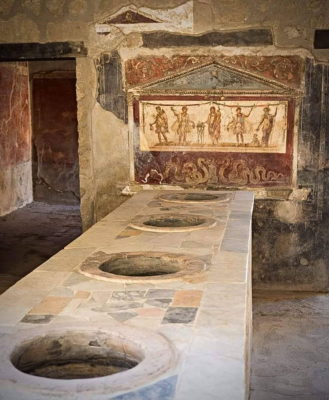The Thermopolium of Vetutius Placidius in Pompeii offers a fascinating look into the daily lives of ancient Romans, revealing a bustling fast-food culture that catered to the city’s busy inhabitants. This well-preserved establishment provides invaluable insights into the social and economic dynamics of Pompeii before its tragic destruction.
A Hub of Daily Life in Ancient Pompeii
Thermopolia, like that of Vetutius Placidius, were integral to the social and economic fabric of Pompeii, serving as convenient dining spots for its residents.
Catering to the Busy Roman Lifestyle
Thermopolia functioned much like modern fast-food restaurants, providing quick and affordable meals to Romans on the go.
- Convenience and Efficiency:
- These establishments offered a convenient dining option for workers and those without access to private kitchens.
- The rapid service allowed busy Romans to grab a quick meal without disrupting their daily routines.
- Social Gathering Place:
- Thermopolia served as social hubs where people could gather, eat, and socialize.
- They facilitated interactions and exchanges within the community.
- Economic Significance:
- These businesses played a vital role in Pompeii’s economy, providing employment and generating revenue.
- Thermopolia where a place that lower class people could afford to eat.

The Thermopolium of Vetutius Placidius: A Well-Preserved Example
Among the numerous thermopolia discovered in Pompeii, that of Vetutius Placidius stands out for its exceptional preservation.
- Archaeological Significance:
- The thermopolium’s well-preserved state offers valuable insights into the architecture, decor, and daily operations of these establishments.
- It allows researchers to reconstruct the sights, sounds, and smells of ancient Pompeii.
- Architectural Features:
- The decorated counter, featuring six large terracotta dolia, is a key architectural feature of the thermopolium.
- These dolia once held hot meals, showcasing the variety of dishes available to customers.
- Evidence of Thriving Business:
- The discovery of a large stash of bronze coins within one of the dolia provides evidence of the thermopolium’s thriving trade.
- These coins offer insights into the economic transactions and financial practices of the time.

Discoveries and Artifacts
The Thermopolium of Vetutius Placidius has provided many artifacts that are helping to paint a picture of daily life in Pompeii.
- The Dolia:
- The large terracotta containers that where used to hold the hot food that was sold at the thermopolium.
- These containers give a good idea of what types of food that the average roman would have been eating.
- The Coins:
- The large amount of bronze coins that where discovered, give insight into the commerce that took place at the thermopolium.
- The coins are now on display at The National Archaeological Museum of Naples.
- The Lararium:
- The well preserved Lararium that is located at the thermopolium, shows how important religion was in the daily lives of the roman people.
- The depictions of the Lari, Genius, Mercury, and Dionysus, are helping historians understand the religious beliefs of the time period.

Insights into Roman Daily Life and Beliefs
The Thermopolium of Vetutius Placidius offers a glimpse into the daily routines, religious beliefs, and culinary practices of ancient Romans.
Religious Devotion and Household Shrines
The thermopolium’s well-preserved lararium highlights the importance of religious devotion in daily Roman life.
- Household Gods:
- The lararium, a shrine dedicated to the household gods, was a common feature in Roman homes and businesses.
- It served as a focal point for daily prayers and offerings.
- Depictions of Deities:
- The depictions of the Lari, Genius, Mercury, and Dionysus reveal the specific deities that were venerated at the thermopolium.
- These depictions provide insights into the religious beliefs and practices of the Romans.
- Integration of Religion and Commerce:
- The presence of a lararium within the thermopolium demonstrates the integration of religion and commerce in Roman society.
- It shows that the roman people believed that the gods had influence in their business dealings.

Culinary Practices and Ingredients
The discovery of food remains and cooking utensils within the thermopolium provides insights into Roman culinary practices.
- Typical Roman Meals:
- The dolia once held hot meals such as chickpeas, beans, and dried fruit, which were common staples in the Roman diet.
- These meals reflect the dietary habits of the average Roman.
- Use of Aromatic Herbs:
- The owner’s private garden, used to grow aromatic herbs, highlights the importance of fresh ingredients in Roman cooking.
- These herbs added flavor and fragrance to the dishes served at the thermopolium.
- Variety of Dishes:
- The thermopolium likely offered a variety of dishes to cater to different tastes and preferences.
- This reflects the diversity of Roman culinary traditions.

Integration of Business and Domestic Life
The thermopolium’s connection to the owner’s residence provides a unique glimpse into the integration of business and domestic life in Pompeii.
- Seamless Transition:
- The seamless transition between the shop and the owner’s residence highlights the close relationship between work and home life.
- This reflects the daily routines of Pompeii’s residents.
- Private Garden:
- The presence of a private garden, used to grow cooking herbs, showcases the self-sufficiency of Roman households.
- It also highlights the importance of fresh ingredients in Roman cuisine.
- Daily Routines:
- The integration of business and domestic life provides insights into the daily routines of Pompeii’s residents before the city’s destruction.
- It helps to show how the people of Pompeii lived their lives.
The Thermopolium of Vetutius Placidius stands as a testament to the vibrant daily life of ancient Pompeii, offering invaluable insights into the city’s fast-food culture, religious beliefs, and culinary practices.

CÁC TIN KHÁC
Mary Walton: The Forgotten Inventor Who Helped Clean Up America’s Cities
Tomb of Queen Nefertari in the Valley of the Queens, Egypt
Discover the Hypostyle Hall of the Temple of Hathor at Dendera
Venus de Losange: Unveiling the Mystery of a 20,000-Year-Old Paleolithic Icon